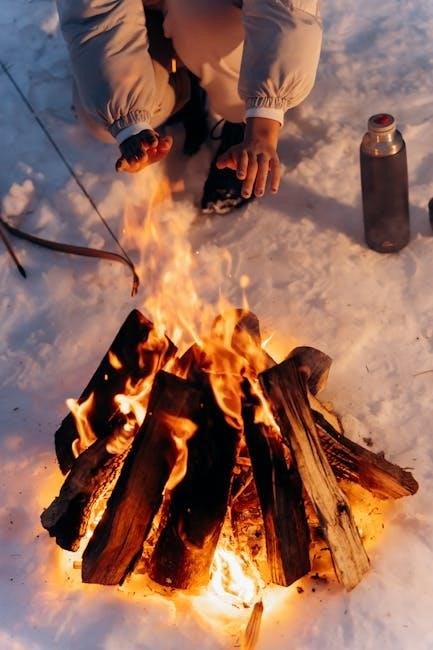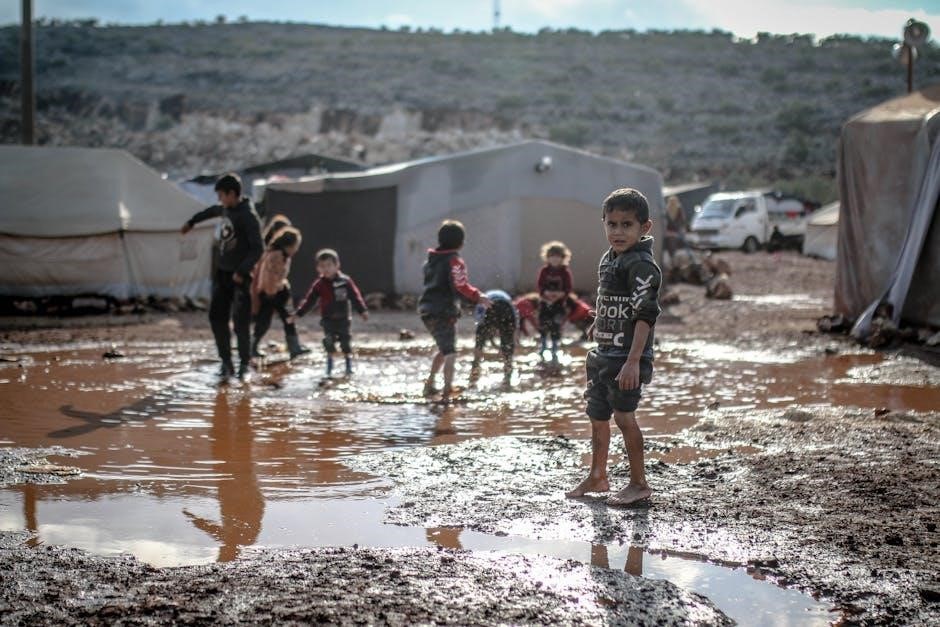
survival guides
Survival guides provide essential knowledge for emergency preparedness, offering practical skills like finding water, building shelter, and starting fires. They emphasize mental resilience and adaptability in hostile environments.
1.1. Importance of Survival Skills in Modern World
Survival skills are crucial in today’s unpredictable world, offering tools for emergency preparedness and self-reliance. They empower individuals to navigate natural disasters, urban crises, and remote challenges, ensuring safety and well-being. Modern survival skills also foster mental resilience, adaptability, and confidence, essential for overcoming unexpected situations and thriving in hostile environments. They are a cornerstone of personal and community safety.
1.2. Key Principles of Survival
The core principles of survival include finding and purifying water, building shelter, and starting a fire. These foundational skills ensure basic needs are met, providing protection from elements and improving morale. Additionally, staying calm, conserving energy, and signaling for help are critical for long-term survival. These principles form the backbone of any effective survival strategy, applicable in diverse environments and scenarios.
Essential Survival Skills
Mastering survival skills like finding resources, building shelter, and starting a fire is crucial for staying alive in critical situations. These skills form the foundation of survival.
2.1. Finding and Purifying Water
Locating water sources is critical for survival. Streams, ponds, and dew collection are reliable methods. Always purify water using boiling, sand filtration, or solar disinfection to ensure safety and prevent waterborne illnesses.
2.2. Building Shelter
Shelter protects from harsh weather and wildlife. Use natural materials like branches, leaves, and snow for construction. Lean-to and debris hut styles are effective. Ensure the structure is sturdy, dry, and well-ventilated to maintain body heat and health.
2.3. Starting a Fire
Fire provides warmth, light, and a method to purify water. Use flint and steel or matches to ignite tinder like dry leaves or grass. Arrange logs in teepee or log cabin formations for airflow. Maintain the fire by gradually adding larger wood pieces to sustain heat and control its size for safety and efficiency.
Food Procurement and Safety
Procuring food safely is vital for survival. Hunt or forage responsibly, avoiding poisonous plants. Ensure food is cooked thoroughly to prevent illness and maintain energy levels.
3.1. Hunting and Foraging
Hunting and foraging are crucial skills for obtaining food in the wild. Identify edible plants and avoid toxic species. Use traps or weapons for hunting, ensuring humane and efficient methods. Familiarize yourself with local wildlife to maximize success while minimizing risks and conserving energy.
3.2. Food Safety and Preservation
Proper food safety and preservation techniques prevent spoilage and foodborne illnesses. Store food in airtight containers to protect from pests. Use methods like smoking, drying, or fermenting to extend shelf life. Always cook meat thoroughly and avoid consuming spoiled or contaminated food to maintain health and energy in survival situations.
Self-Defense and Protection
Self-defense and protection are crucial for survival, involving physical techniques, mental preparedness, and situational awareness to ensure safety in hazardous environments.
4.1. Basic Self-Defense Techniques
Mastering basic self-defense techniques involves assessing threats, using leverage, and targeting vulnerable areas. Staying calm, maintaining awareness, and employing tools like sticks or rocks can enhance protection. Mental preparedness is equally vital, ensuring quick decision-making and effective responses to potential dangers in survival situations.
4.2. Protecting Against Wildlife
Protecting against wildlife requires awareness and proactive measures. Make noise while hiking to avoid startling animals, carry bear spray, and store food securely. Stay calm during encounters, as aggressive behavior can escalate threats. Wearing protective clothing and understanding animal behavior can also minimize risks in wilderness survival situations.
Mental and Emotional Survival
Mental resilience is vital for survival. Techniques like deep breathing and positive thinking help manage stress and fear, ensuring clarity and focus during critical situations.
5.1. Managing Stress and Fear
Managing stress and fear is crucial for survival. Techniques like deep breathing, positive thinking, and staying focused help maintain clarity. Fear is natural but can impair judgment, so controlling it is essential. Prioritize calm decision-making to conserve energy and stay effective in emergencies. Mental discipline ensures resilience and adaptability in challenging situations.
- Practice mindfulness to reduce anxiety.
- Stay focused on immediate goals.
- Reframe fear as a motivational tool.
5.2. Staying Positive and Focused
Staying positive and focused is vital for survival. Positive thinking helps maintain mental clarity and motivation. Setting small, achievable goals can foster a sense of accomplishment. Visualization techniques and gratitude practices reinforce resilience. Keeping a focused mindset ensures better decision-making and energy conservation, enabling you to stay determined and proactive in challenging situations;
- Set realistic goals to maintain motivation.
- Use visualization to stay determined.
- Practice gratitude to improve mental state.
Signaling for Help
Signaling for help is crucial for rescue. Use smoke, mirrors, or flares to attract attention. Create visible ground markings or use reflective objects to signal your location effectively.
- Use smoke during the day for visibility.
- Reflect sunlight with shiny objects.
- Create large, visible ground signs.
6.1. Using Smoke and Fire Signals
Smoke and fire are effective signaling methods. Create smoke during the day by burning green leaves or wet wood. At night, build a large fire on a hilltop or clearing. Use three short bursts of smoke or fire to signal distress. Ensure the fire is visible from afar and control it to avoid unintended spreading;
6.2. Creating Visible Markings
Create large, visible markings using natural materials like rocks, logs, or branches. Arrange them in geometric shapes or arrows to indicate direction. Use contrasting colors or reflective objects to enhance visibility. Marking paths or trails can guide rescuers to your location. Ensure markings are clear and easily spotted from a distance, maintaining them regularly for effectiveness.

First Aid and Wound Care
Mastering first aid is crucial for treating injuries in survival situations. Clean wounds thoroughly, apply dressings, and use tourniquets when necessary to control bleeding. Monitor healing to prevent infection.
7.1. Basic First Aid Techniques
Essential first aid techniques include cleaning wounds with safe water, applying pressure to stop bleeding, and using bandages to protect injuries. Assessing the situation, immobilizing broken limbs, and monitoring vital signs are critical steps. Knowing these basics can significantly improve chances of recovery and prevent minor injuries from becoming life-threatening in survival scenarios.
7.2. Treating Injuries in the Wild
Treating injuries in the wild requires resourcefulness and quick action. Clean wounds with purified water and apply natural antiseptics like plant extracts. Splint fractures using sticks and cloth, and manage pain with available remedies. Prevent infection by keeping wounds dry and monitoring for signs of swelling or redness, ensuring proper healing in remote environments without medical aid.

Navigation and Orientation
Navigation and orientation are crucial for survival, involving the use of compasses, maps, and natural signs like the sun, stars, and landmarks to determine direction and location accurately.
8.1. Using Compass and Maps
Mastering the use of a compass and maps is vital for navigation. A compass provides directional guidance, while maps offer terrain details. Always carry a reliable compass and up-to-date maps, ensuring you can pinpoint your location and plan the safest route, even in unfamiliar territories. Proper orientation prevents disorientation and enhances survival chances significantly.
8.2. Natural Navigation Methods
Natural navigation relies on observing the environment, using the sun’s position, stars, and landmarks. Learn to identify cardinal directions via shadows or the North Star. Recognize natural features like rivers flowing toward larger bodies of water or vegetation density indicating water sources. These methods conserve tools and enhance survival by leveraging nature’s inherent guidance.

Wildlife and Insect Encounters
Understanding how to avoid dangerous animals and treat bites is crucial for survival. Use preventive tactics and protective clothing to minimize risks and stay safe.
9.1. Avoiding Dangerous Animals
Avoiding dangerous animals requires awareness and caution. Recognize animal tracks, use protective clothing, and stay alert in high-risk areas. Maintain a safe distance and avoid sudden movements to prevent encounters. Understanding animal behavior helps in predicting threats and taking appropriate measures to ensure safety in the wild.
9.2. Treating Insect Bites and Stings
Treating insect bites involves cleaning the area with soap and water, applying cold compresses to reduce swelling, and using antihistamines or calamine lotion for itching. For stings, remove the stinger gently and avoid scratching. Severe reactions may require immediate medical attention, including epinephrine for anaphylaxis. Monitor for signs of infection and seek professional help if symptoms worsen.
Packing the Right Gear
A survival kit should include essentials like a knife, flashlight, first aid kit, water filter, rope, and multi-tool. Pack extra clothing, blankets, and a portable shelter.
10.1. Essential Items for a Survival Kit
A survival kit should include a knife, flashlight, first aid kit, water filter, rope, multi-tool, and fire starters. Add extra clothing, blankets, a portable shelter, and a map. Include a whistle for signaling and a small stash of non-perishable food. Don’t forget a waterproof bag to keep everything dry and accessible in emergencies.
10.2. Choosing the Right Clothing
Select clothing that offers protection, durability, and versatility. Opt for breathable, moisture-wicking fabrics like cotton or polyester. Include layers for temperature regulation—base layers, insulating fleece, and waterproof outerwear. Sturdy footwear is essential for rough terrain. Don’t forget hats, gloves, and extra socks to prevent heat loss and blisters. Choose earth-toned colors for camouflage and visibility in various environments.
Survival in Extreme Weather
Extreme weather demands preparedness. Use waterproof clothing, maintain body heat, and protect your head and neck; Stay hydrated and avoid overexertion. Seek shelter from wind, rain, or snow.
11.1. Surviving in Freezing Conditions
Surviving freezing conditions requires layering clothing, staying dry, and building shelter. Use snow walls or natural caves for protection. Start a fire for warmth and melt snow for water. Ration food and energy, as hypothermia can set in quickly. Stay positive and avoid panic to maintain mental resilience in harsh, cold environments.
11.2. Coping with Extreme Heat
Coping with extreme heat involves staying hydrated, wearing light, loose clothing, and seeking shade. Avoid activity during the hottest parts of the day. Use cooling techniques like wet cloths or evaporative cooling. Ration food and water, and be aware of heat-related illnesses. Stay vigilant and adapt routines to survive prolonged high temperatures effectively.
Urban Survival Tips
Urban survival requires adaptability, situational awareness, and resourcefulness. Know the city layout, locate safe water sources, and stay informed about potential risks and available resources.
12;1. Navigating Urban Environments
Navigating urban environments during survival requires mapping skills, knowledge of safe zones, and awareness of potential hazards. Utilize landmarks, avoid crowded areas, and stay informed about local conditions to enhance safety and resource access efficiently in city settings.
12.2. Finding Resources in the City
Finding resources in the city involves locating essential supplies like food, water, and tools. Identify grocery stores, pharmacies, and public water sources. Be cautious of hazards and competition for resources. Utilize abandoned or less crowded areas to scavenge safely, ensuring sustainability and minimizing risks in urban survival scenarios.

Long-Term Survival Strategies
Long-term survival requires sustainable practices, such as creating reliable food sources, managing water supply, and establishing durable shelter. Adaptability and mental resilience are crucial for enduring challenging conditions over extended periods.
13.1. Creating a Sustainable Food Source
Creating a sustainable food source is vital for long-term survival. Techniques include farming, fishing, and foraging. Farming requires knowledge of soil and crop rotation, while fishing needs durable gear. Foraging involves identifying edible plants safely. These methods ensure a steady food supply, reducing reliance on limited resources and enhancing survival chances in challenging environments effectively.
13.2. Building a Long-Term Shelter
Building a long-term shelter requires durability and protection from elements. Techniques include constructing cabins, earth-sheltered homes, or repurposing natural structures. Materials like wood, stone, and thatch are ideal. Proper insulation, drainage, and ventilation are crucial for comfort and safety. A well-built shelter ensures protection from harsh weather and wildlife, enhancing survival chances in extended wilderness stays significantly.